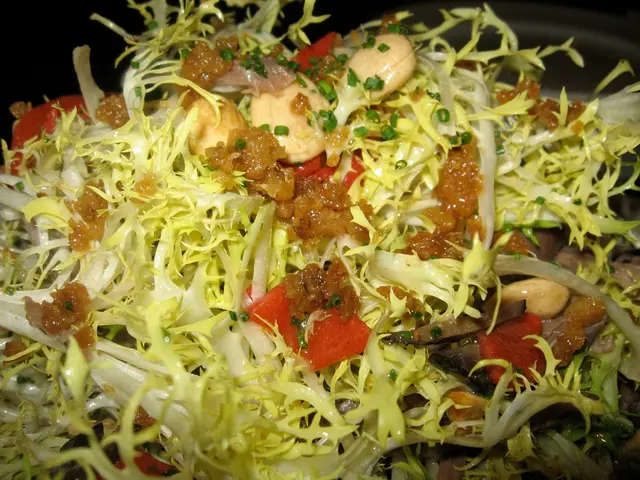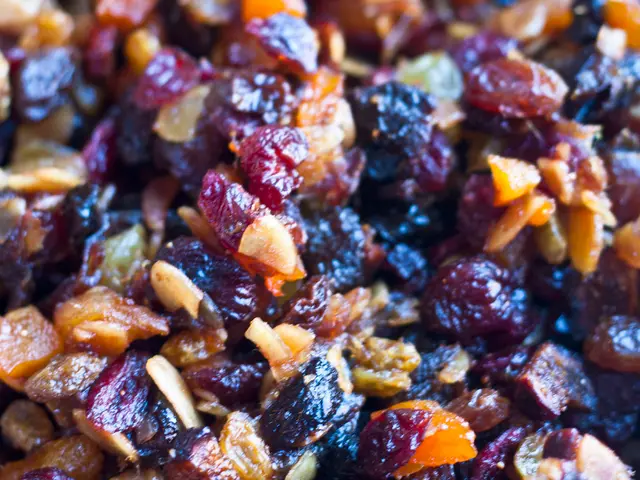Guideline for Feeding a Two-Year-Old Baby
Introducing a Holistic Approach to Feeding 2-Year-Old Children
A well-balanced diet is vital for a 2-year-old child's growth and development. By incorporating a variety of foods from the five main food groups, children can receive essential vitamins, minerals, and nutrients for their physical, mental, and emotional well-being[2][3].
Key Benefits:- Foster healthy growth and development- Strengthen the immune system- Promote brain function and emotional health- Establish positive eating habits- Provide consistent energy and minimize behavioral issues
Nutritional Requirements:- Grains: 3–5 ounces daily (e.g., bread, rice, or oats)- Vegetables: 1–2 cups daily, including various soft, cooked options- Fruit: 1 cup daily, such as bananas, apples, or grapes- Protein: Approximately 13–15 grams daily, based on body weight (0.5 grams per pound)- Dairy: 1 cup or 2 ounces of cheese daily, fortified with calcium if necessary[1]
A balanced diet is often more effective than supplements for most healthy children, as whole foods offer a better source of nutrients and aid in the development of taste preferences and healthy routines[5][1].
To assist parents in planning their child's meals, we present meal plans and a food chart for 2-year-old babies, which aim to maintain a balance of nutrients across meals. While each child is unique, it is essential to adapt the diet according to their preferences[2].
Steps to Develop Healthy Eating Habits:1. Establish a regular feeding schedule to ease the child into fixed meal times.2. Avoid providing snacks or liquid foods before meals.3. Offer nutrient-dense foods to ensure a complete nutrition intake.4. Teach eating etiquette and encourage slow eating.5. Avoid unhealthy junk foods.
Foods for 2-Year-Old Babies:Your toddler's body undergoes rapid development at this stage, necessitating a diverse range of foods from all food groups to provide complete nutrition.
Important Foods:- Dairy and dairy products (cheese, yogurt, buttermilk)- Vegetables (green, orange, yellow, red, purple, and white)- Fruits (green, orange, yellow-red, and purple)- Meat (lean chicken)- Fish (salmon, tuna)- Healthy oils (nuts, seeds)- Citrus fruits (oranges, lemons)
Sunlight remains an important source of Vitamin D for strong bones[6].
Optional Recommended Products:- Kids & Teens Brain Booster Veggies and Dal Powder- Brain Development Diet Plan: Boost Brain in 30-Days- Kids & Teens Daily Nutrition Chocolate Spread- Online Home Therapy Course for Sitting Tolerance
By adopting a balanced diet and fostering a love for various healthy foods, parents can help their children develop lifelong healthy eating habits.
- The growth and development of a 2-year-old child depends significantly on a well-balanced diet, containing essential nutrients from various food groups like grains, vegetables, fruit, protein, and dairy.
- A balanced diet not only supports brain development but also emotional health and the establishment of positive eating habits in children, providing consistent energy and minimizing behavioral issues.
- Science reveals that a consistent and nutritious diet in early childhood can strengthen a child's immune system and promote overall health-and-wellness.
- Parents play a crucial role in their 2-year-old's growth and development, as they can help create a healthy lifestyle by preparing meals that maintain a balance of nutrients across meals.
- To facilitate this, we provide meal plans and a food chart for 2-year-old babies, along with recommendations for optional nutritional products to further support brain development and development of lifelong healthy eating habits.








